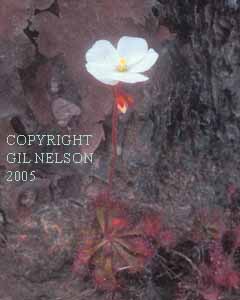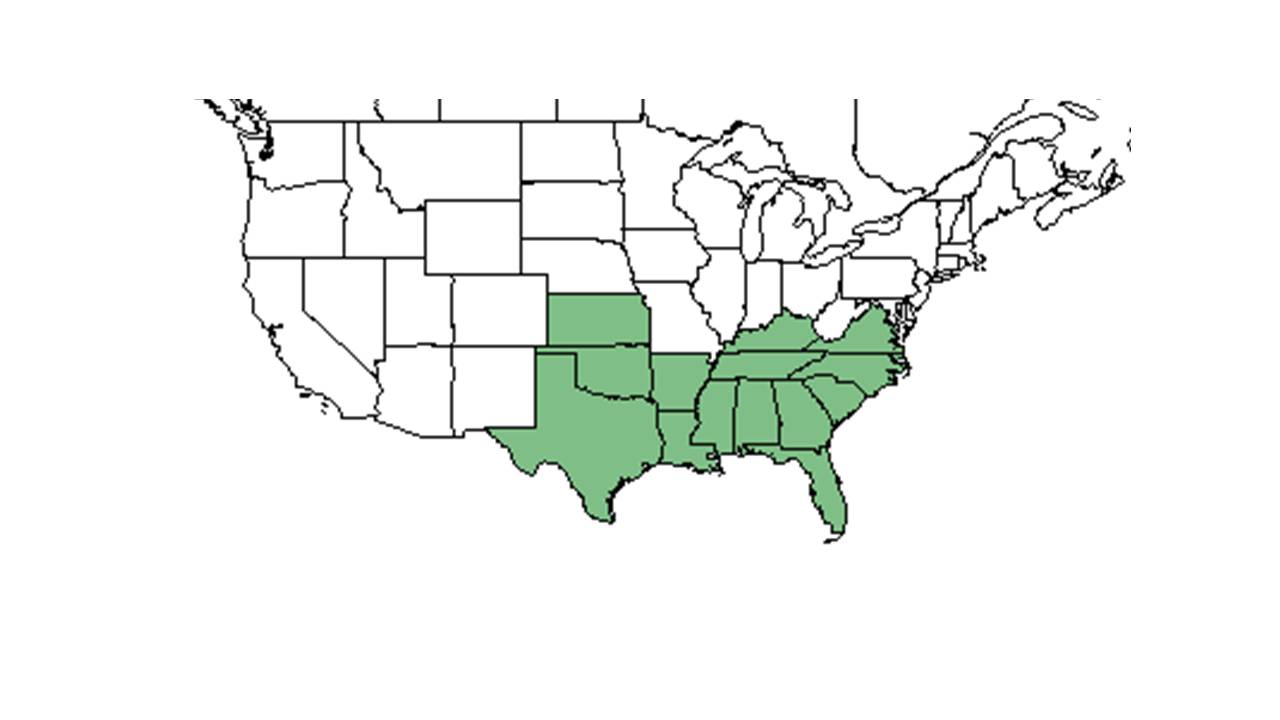Difference between revisions of "Drosera brevifolia"
HaleighJoM (talk | contribs) (→Ecology) |
|||
| (10 intermediate revisions by 7 users not shown) | |||
| Line 20: | Line 20: | ||
Common name: Dwarf sundew | Common name: Dwarf sundew | ||
==Taxonomic notes== | ==Taxonomic notes== | ||
| − | Synonym: ''Drosera leucantha'' Shinners | + | Synonym: ''Drosera leucantha'' Shinners.<ref name="weakley">Weakley, A.S. 2015. Flora of the southern and mid-atlantic states. Working Draft of 21 May 2015. University of North Carolina at Chapel Hill, Chapel Hill, North Carolina.</ref> |
| + | |||
| + | Varieties: none.<ref name="weakley">Weakley, A.S. 2015. Flora of the southern and mid-atlantic states. Working Draft of 21 May 2015. University of North Carolina at Chapel Hill, Chapel Hill, North Carolina.</ref> | ||
| + | |||
==Description== | ==Description== | ||
<!-- Basic life history facts such as annual/perrenial, monoecious/dioecious, root morphology, seed type, etc. --> | <!-- Basic life history facts such as annual/perrenial, monoecious/dioecious, root morphology, seed type, etc. --> | ||
| Line 38: | Line 41: | ||
Associated species include ''Aristida stricta, Helianthus radula, H. heterophyllus, Pinguicula lutea, Drosera capillaris, Sarracenia psittacina, Polygala, Pinguicula pumila, Utricularia,'' longleaf pine, pine, saw palmetto.<ref name=fsu/> | Associated species include ''Aristida stricta, Helianthus radula, H. heterophyllus, Pinguicula lutea, Drosera capillaris, Sarracenia psittacina, Polygala, Pinguicula pumila, Utricularia,'' longleaf pine, pine, saw palmetto.<ref name=fsu/> | ||
| + | |||
| + | ''Drosera brevifolia'' is frequent and abundant in the Central Florida Flatwoods/Prairies, Peninsula Savannas, and Panhandle Seepage Savannas community types as described in Carr et al. (2010).<ref>Carr, S.C., K.M. Robertson, and R.K. Peet. 2010. A vegetation classification of fire-dependent pinelands of Florida. Castanea 75:153-189.</ref> | ||
===Phenology=== <!--Timing off flowering, fruiting, seed dispersal, and environmental triggers. Cite PanFlora website if appropriate: http://www.gilnelson.com/PanFlora/ --> | ===Phenology=== <!--Timing off flowering, fruiting, seed dispersal, and environmental triggers. Cite PanFlora website if appropriate: http://www.gilnelson.com/PanFlora/ --> | ||
| − | + | ''D. brevifolia'' has been observed flowering in March through May and in October with peak inflorescence in April.<ref name=fsu>Florida State University Robert K. Godfrey Herbarium database. URL: http://herbarium.bio.fsu.edu. Last accessed: June 2014. Collectors: James R. Burkhalter, Loran C. Anderson, Robert K. Godfrey, Robert Kral, L. B. Trott, Kathy Craddock Burks, Harry Alden, Loran C. Anderson, Douglas Newton, Philip Greear, H. K. Svenson, B. H. Warnock, C. J. Hansen, C. M. Morton, Lisa Keppner, Ed Keppner, D. S. Correll, Helen B. Correll, E. C. Ogden, H. K. Svenson, and A. E. Radford. States and Counties: Florida: Escambia, Gadsden, Liberty, Jackson, Franklin, Jefferson, Madison, Leon, Bay, Calhoun, Nassau, Wakulla, and Washington. Georgia: Grady, Bulloch, Bartow, and Thomas. Tennessee: Coffee. Texas: Austin, Hardin, and Freestone. Alabama: Lee and Mobile. North Carolina: Hyde.</ref><ref>Nelson, G. [http://www.gilnelson.com/ PanFlora]: Plant data for the eastern United States with emphasis on the Southeastern Coastal Plains, Florida, and the Florida Panhandle. www.gilnelson.com/PanFlora/ Accessed: 8 DEC 2016</ref> | |
===Seed dispersal=== | ===Seed dispersal=== | ||
It is found in the seed bank of disturbed and non-disturbed sites.<ref name="Cohen et al 2004">Cohen, S., R. Braham, et al. (2004). "Seed bank viability in disturbed longleaf pine sites." Restoration Ecology 12: 503-515.</ref> | It is found in the seed bank of disturbed and non-disturbed sites.<ref name="Cohen et al 2004">Cohen, S., R. Braham, et al. (2004). "Seed bank viability in disturbed longleaf pine sites." Restoration Ecology 12: 503-515.</ref> | ||
| − | + | ||
| + | ===Seed bank and germination=== | ||
| + | It was found viable and almost ubiquitous in the seed bank of a pine flatwoods community in Florida after more than 30 years of fire exclusion.<ref>Maliakal, S.K., E.S. Menges and J.S. Denslow. 2000. Community composition and regeneration of Lake Wales Ridge wiregrass flatwoods in retlation to time-since-fire. Journal of the Torrey Botanical Society 127:125-138.</ref> | ||
| + | |||
| + | An early 2000s study found that while ''D. breviolia'' is found in the seed beds of pine flatwoods soils, it is absent from the seed banks in soils of old agricultural fields.<ref name= Jenkins> Jenkins, Amy Miller. Seed banking and vesicular-arbuscular mycorrhizae in pasture restoration in central Florida. University of Florida. 2003.</ref> | ||
| + | |||
===Fire ecology=== <!--Fire tolerance, fire dependence, adaptive fire responses--> | ===Fire ecology=== <!--Fire tolerance, fire dependence, adaptive fire responses--> | ||
This species occurs in habitat that burns frequently.<ref name=fsu/> | This species occurs in habitat that burns frequently.<ref name=fsu/> | ||
| − | <!--Pollination===--> | + | <!--===Pollination===--> |
| − | <!--=== | + | <!--===Herbivory and toxicology===--> |
<!--===Diseases and parasites===--> | <!--===Diseases and parasites===--> | ||
| − | ==Conservation and | + | ==Conservation, cultivation, and restoration== |
| − | == | + | ==Cultural use== |
==Photo Gallery== | ==Photo Gallery== | ||
<gallery widths=180px> | <gallery widths=180px> | ||
Latest revision as of 20:03, 27 June 2022
| Drosera brevifolia | |
|---|---|

| |
| Photo taken by Gil Nelson | |
| Scientific classification | |
| Kingdom: | Plantae |
| Division: | Magnoliophyta - Flowering plants |
| Class: | Magnoliopsida – Dicotyledons |
| Order: | Nepenthales |
| Family: | Droseraceae |
| Genus: | Drosera |
| Species: | D. brevifolia |
| Binomial name | |
| Drosera brevifolia Pursh | |

| |
| Natural range of Drosera brevifolia from USDA NRCS Plants Database. | |
Common name: Dwarf sundew
Contents
Taxonomic notes
Synonym: Drosera leucantha Shinners.[1]
Varieties: none.[1]
Description
Drosera brevifolia is a carnivorous plant.
Generally, for the Drosera genus, they are an "annual or a perennial, rosulate, scapose herbs. Leaves with tentacle-like, glandular trichomes, the glistening, sticky secretion of each gland contributing to the insect-catching function of the leaf, and to the common name. Flowers perfect, actinomorphic, 5-merous; sepals and petals persistent, enclosing the capsule; stamens 5; ovary syncarpous, superior, 1-locular. Capsule valvate, seeds minute."[2]
Specifically, for. D. brevifolia, the species has "leaves that are obovate to spatulate, cuneate, 7-16 mm long including the indistinct petiole. Scape glandular pubescent, 2-6 cm long; pedicels and calyces glandular pubescent; corolla white, sometimes tinged with pink, 5-7 mm long. Seeds black, irregularly obovoid, less than 0.5 mm long, minutely reticulate." [2]
Distribution
Ranges from east Texas to Florida and north to Virginia.[3]
Ecology
D. brevifolia is an insectivorous plant with hairs on the basal leaves that produce a clear sticky liquid that attracts and traps insects.[4]
Habitat
D. brevifolia occurs in moist to wet, sandy or peaty soils. It also seems to prefer more open conditions that provide higher light levels.[5] It can be found in longleaf pine communities,[6] pine-saw palmetto flats, open glades, and at the margins of marshes, grass-sedge bogs, ponds, and swamps. It also occurs in some disturbed areas that are moist and open, including power line corridors, cutover pinewoods, roadside ditches, open fields, and mowed lawns.[5]
Associated species include Aristida stricta, Helianthus radula, H. heterophyllus, Pinguicula lutea, Drosera capillaris, Sarracenia psittacina, Polygala, Pinguicula pumila, Utricularia, longleaf pine, pine, saw palmetto.[5]
Drosera brevifolia is frequent and abundant in the Central Florida Flatwoods/Prairies, Peninsula Savannas, and Panhandle Seepage Savannas community types as described in Carr et al. (2010).[7]
Phenology
D. brevifolia has been observed flowering in March through May and in October with peak inflorescence in April.[5][8]
Seed dispersal
It is found in the seed bank of disturbed and non-disturbed sites.[6]
Seed bank and germination
It was found viable and almost ubiquitous in the seed bank of a pine flatwoods community in Florida after more than 30 years of fire exclusion.[9]
An early 2000s study found that while D. breviolia is found in the seed beds of pine flatwoods soils, it is absent from the seed banks in soils of old agricultural fields.[10]
Fire ecology
This species occurs in habitat that burns frequently.[5]
Conservation, cultivation, and restoration
Cultural use
Photo Gallery
References and notes
- ↑ 1.0 1.1 Weakley, A.S. 2015. Flora of the southern and mid-atlantic states. Working Draft of 21 May 2015. University of North Carolina at Chapel Hill, Chapel Hill, North Carolina.
- ↑ 2.0 2.1 Radford, Albert E., Harry E. Ahles, and C. Ritchie Bell. Manual of the Vascular Flora of the Carolinas. 1964, 1968. The University of North Carolina Press. 516-7. Print.
- ↑ [[1]]Encyclopedia of Life. Accessed: April 29, 2016
- ↑ [[2]]Lady Bird Johnson Wildflower Center. Accessed: April 29, 2016
- ↑ 5.0 5.1 5.2 5.3 5.4 Florida State University Robert K. Godfrey Herbarium database. URL: http://herbarium.bio.fsu.edu. Last accessed: June 2014. Collectors: James R. Burkhalter, Loran C. Anderson, Robert K. Godfrey, Robert Kral, L. B. Trott, Kathy Craddock Burks, Harry Alden, Loran C. Anderson, Douglas Newton, Philip Greear, H. K. Svenson, B. H. Warnock, C. J. Hansen, C. M. Morton, Lisa Keppner, Ed Keppner, D. S. Correll, Helen B. Correll, E. C. Ogden, H. K. Svenson, and A. E. Radford. States and Counties: Florida: Escambia, Gadsden, Liberty, Jackson, Franklin, Jefferson, Madison, Leon, Bay, Calhoun, Nassau, Wakulla, and Washington. Georgia: Grady, Bulloch, Bartow, and Thomas. Tennessee: Coffee. Texas: Austin, Hardin, and Freestone. Alabama: Lee and Mobile. North Carolina: Hyde.
- ↑ 6.0 6.1 Cohen, S., R. Braham, et al. (2004). "Seed bank viability in disturbed longleaf pine sites." Restoration Ecology 12: 503-515.
- ↑ Carr, S.C., K.M. Robertson, and R.K. Peet. 2010. A vegetation classification of fire-dependent pinelands of Florida. Castanea 75:153-189.
- ↑ Nelson, G. PanFlora: Plant data for the eastern United States with emphasis on the Southeastern Coastal Plains, Florida, and the Florida Panhandle. www.gilnelson.com/PanFlora/ Accessed: 8 DEC 2016
- ↑ Maliakal, S.K., E.S. Menges and J.S. Denslow. 2000. Community composition and regeneration of Lake Wales Ridge wiregrass flatwoods in retlation to time-since-fire. Journal of the Torrey Botanical Society 127:125-138.
- ↑ Jenkins, Amy Miller. Seed banking and vesicular-arbuscular mycorrhizae in pasture restoration in central Florida. University of Florida. 2003.